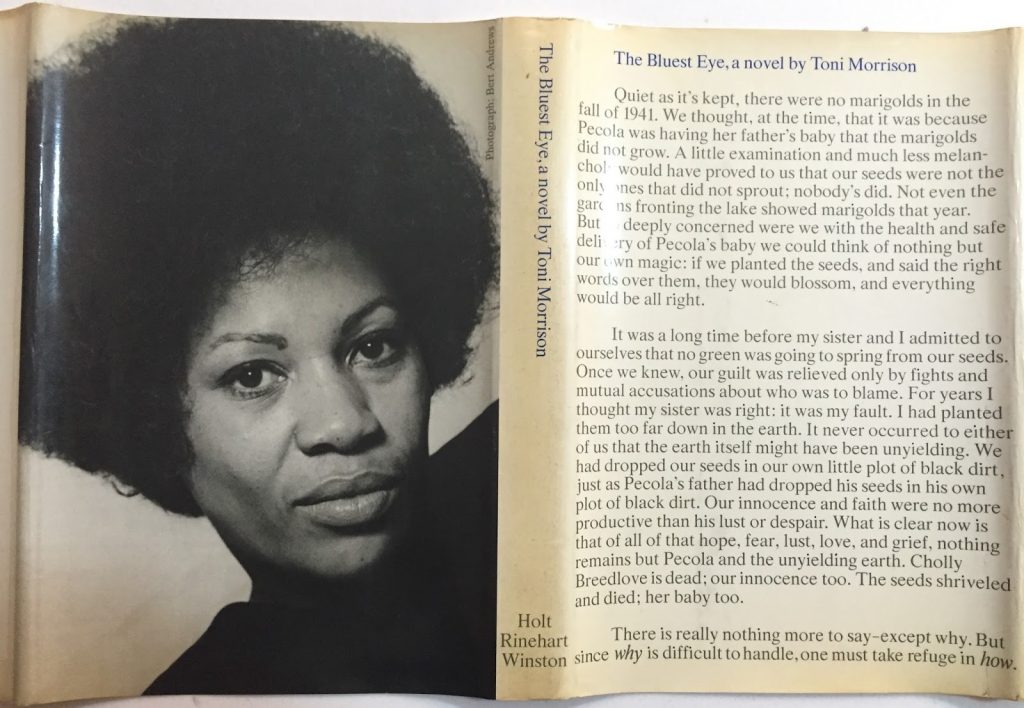
The original dust jacket for the hard cover first edition of The Bluest Eye, with photo of Toni Morrison by Bert Andrews.
The passing of Toni Morrison in August 2019 at the age of 88 opened a floodgate of tributes from around the world. The native of Lorain, Ohio, had climbed heights no other American writer of the past half-century had achieved, winning every major award from the Pulitzer Prize to the Presidential Medal of Freedom and, in 1993, the Nobel Prize for Literature.
This month marks a milestone in Morrison’s life and career. It was 50 years ago, in November 1970, when her first novel, The Bluest Eye, was published by Holt, Rinehart & Winston. At the time, Morrison was working as a textbook editor for L.W. Singer. Because she was a relatively unknown writer, the initial print run in hardcover was only 2,000 copies. But it brought her acclaim, which would continue to grow with her second novel, Sula (for which Morrison won her first literary prize – the Ohioana Book Award in fiction), and her third, Song of Solomon, which solidified her position as one of America’s greatest writers.
With controversial themes that include incest and rape, The Bluest Eye has often been challenged as high school reading material and has appeared several times among the list of titles most frequently banned. But in the 50 years since its publication, it has become a classic.
For those not familiar with the novel, Chiquita Mullins-Lee, herself an award-winning poet and playwright, as well as the Arts Learning Coordinator for the Ohio Arts Council, offers this summary:
“The Bluest Eye presents a treatise on slavery’s legacy of self-loathing and self-rejection. Toni Morrison channels the generational trauma of a little black girl who internalizes societal norms that devalue her looks, culture, and very existence. In Pecola Breedlove’s world, Black value and Black beauty are non-entities. From a deeply broken spirit, Pecola identifies the prize: blues eyes promise entry into a place that privileges white skin and tolerates the physical features of a “high yellow dream child.” In possession of neither blue eyes nor light skin, Pecola languishes in a world that fails to affirm her. That same destruction of the spirit is revealed in the pathology of her father, Cholly Breedlove, who exemplifies one who has received and transmitted a lethal legacy that fractured families. Ironically, the acquisition of blue eyes could be only a superficial, as well as impossible, fix. Toni Morrison assigns Black folks the responsibility to cherish our children, love ourselves, and heal our spirits and community.”
In 1988, the year Morrison won the Pulitzer Prize for her most acclaimed novel, Beloved, and also received the Ohioana Career Medal, she did an interview with Thames Television on the subject “Why I Wrote The Bluest Eye,” which you can watch on YouTube:
One of the fascinating aspects of Morrison’s writing was her meticulous care and attention to detail. In an article for The Paris Review, she wrote:
We began to talk about little rituals that one goes through before beginning to write. I, at first, thought I didn’t have a ritual, but then I remembered that I always get up and make a cup of coffee while it is still dark—it must be dark—and then I drink the coffee and watch the light come. And she said, Well, that’s a ritual. And I realized that for me this ritual comprises my preparation to enter a space that I can only call nonsecular . . . Writers all devise ways to approach that place where they expect to make the contact, where they become the conduit, or where they engage in this mysterious process. For me, light is the signal in the transition. It’s not being in the light, it’s being there before it arrives. It enables me, in some sense.
Ohioana board member Dionne Custer Edwards, who is also a poet and Director of Learning and Public Practice at the Wexner Center for the Arts, spoke on the impact Morrison’s words had on her:
“As a mother of three, I too often think about rituals of making inside of the demands of work and life. About how to shape lines, images, narratives, and texture—especially in these days—in the midst of a societal crisis, or two or three. I think about pursuing language in an enduring moment where living is a pattern of abundant isolation from breath, sound, movement, people. I think about life as it once was and grieve it with dignity and a few fresh notes of comfort when I am reminded by the sky that I am still breathing even as I consider the enduring length of suffering. I think about time. About how I have often captured the practice of writing in the draft along the wood floors between deep quiet in the house and the folds of sunrise.
I remember meeting Toni Morrison while I was an undergraduate student at Ohio State University. I will never forget how she stayed with a small group of us after her public talk. How she advised, encouraged, held us in a moment of wisdom, comfort, and candor. How she shared ideas about writing and how to make use of hours and space. Back then, I was an English major trying to figure out what to do with my words. So grateful to have lived during a time when Toni Morrison wrote about the complexities of Black lives as real and imagined experiences in literature. ”
The complexities of Black lives as real and imagined experiences in literature that began 50 years ago with The Bluest Eye.
With special thanks to Chiquita Mullins Lee and Dionne Custer Edwards.
